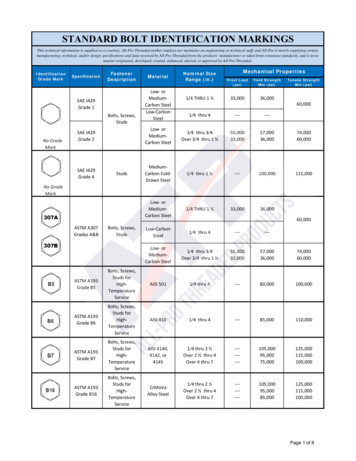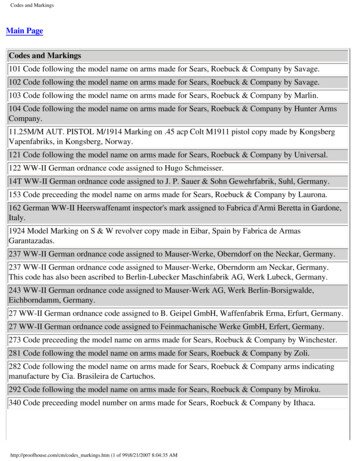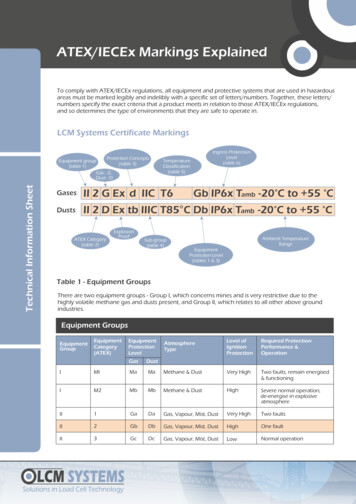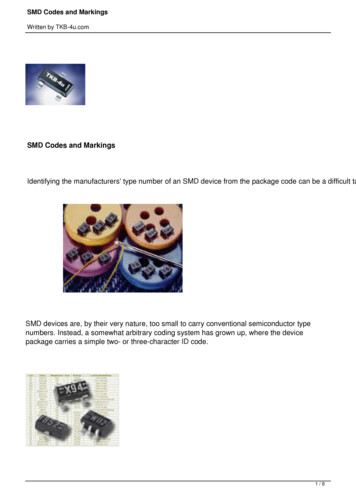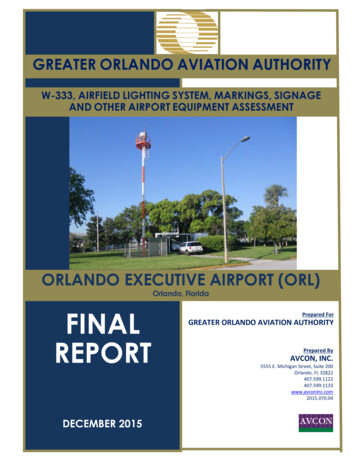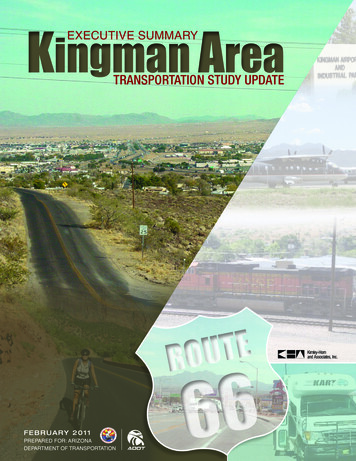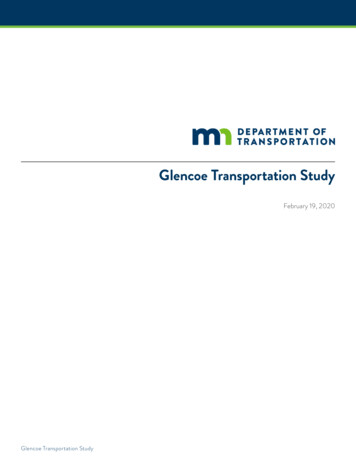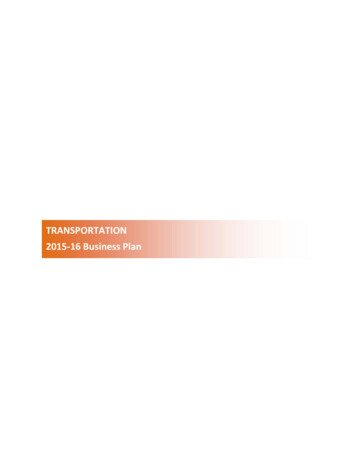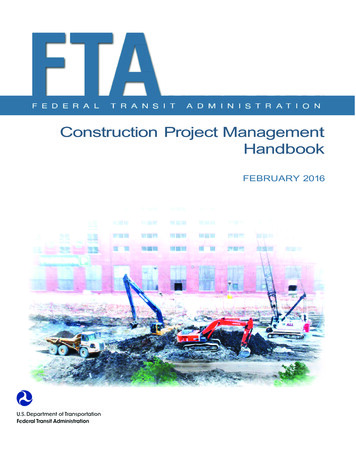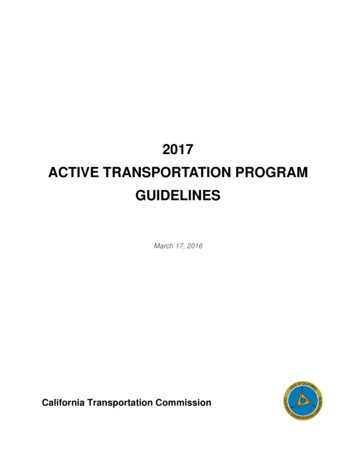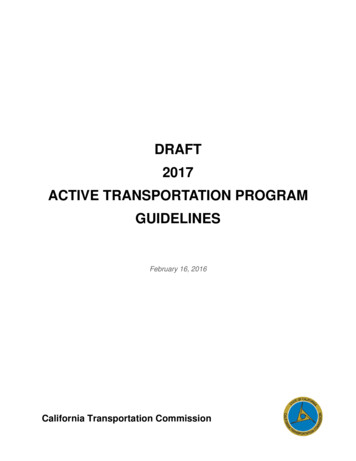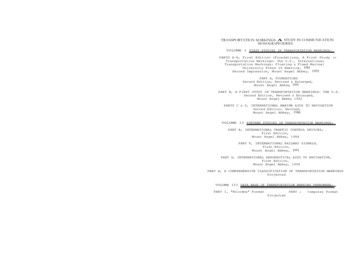
Transcription
TRANSPORTATION MARKINGS: A STUDY IN COMMUNICATIONMONOGRAPH SERIESVOLUME I FIRST STUDIES IN TRANSPORTATION MARKINGS:PARTS A-D, First Edition (Foundations, A First Study inTransportation Markings: The U.S., InternationalTransportation Markings: Floating & Fixed Marine]University Press of America, 1981Second Impression, Mount Angel Abbey, 1993PART A, FOUNDATIONSSecond Edition, Revised & Enlarged,Mount Angel Abbey 1991PART B, A FIRST STUDY IN TRANSPORTATION MARKINGS: THE U.S.Second Edition, Revised & Enlarged,Mount Angel Abbey 1992PARTS C & D, INTERNATIONAL MARINE AIDS TO NAVIGATIONSecond Edition, Revised,Mount Angel Abbey, 1988VOLUME II FURTHER STUDIES IN TRANSPORTATION MARKINGS:PART E, INTERNATIONAL TRAFFIC CONTROL DEVICES,First Edition,Mount Angel Abbey, 1984PART F, INTERNATIONAL RAILWAY SIGNALS,First Edition,Mount Angel Abbey, 1991PART G, INTERNATIONAL AERONAUTICAL AIDS TO NAVIGATION,First Edition,Mount Angel Abbey, 1994PART H, A COMPREHENSIVE CLASSIFICATION OF TRANSPORTATION MARKINGSProjectedVOLUME III DATA BASE OF TRANSPORTATION MARKING PHENOMENA:PART I, "Rolodex" FormatPART J,ProjectedComputer Format
TRANSPORTATION MARKINGS: A STUDY INCOMMUNICATION MONOGRAPH SERIESVOLUME II FURTHER STUDIES INTRANSPORTATION MARKINGSPART GINTERNATIONAL AERONAUTICAL NAVIGATION AIDSBrian ClearmanMount Angel Abbey1994
Dedicated to the Memory ofLDC, 1928-1992Copyright (c) 1994 by Mount Angel Abbeyat Saint Benedict, Oregon 97373All Rights ReservedLibrary of Congress Cataloging-in-Publication DataCiearman, Brian.International aeronautical navigation aids / Brian Clearsan.cm. -- (Transportation markings . v. 2) (Further studiesp.in transportation markings : pt. GIand indexes.1Includes bibliographical references (p.ISBN 0-918941-08-32. Traffic signs1. Airports--Traffic control--Display systems.I. Title.II. Series.3. Aids to air navigation.and signals.III. Series.Transportation markings , v. 2.Clearaan, Brian.Further studies in transportation markings : pt.CIearman, Brian.G.TAl245.C56 1984 vol. 2. pt. G( TL725.3.547]629'.042 s--dc20( 629.12194-14557CIPNote: the LC # preassigned to this monograph is differentthan the one printed in the CIP data sheet. The preassignedS is 94-076173
TABLE OF CONTENTSviiviiiPrefaceAcknowledgmentsAbbreviations .33 AERONAUTICAL NAVIGATION AIDS: INTRODUCTION &EARLY DEVELOPMENTSA Introduction1 Terminology, The Nature ofAero Transportation Markings &Methodological Concerns .2 Aeronautical Nov Aids: PhysicalProperties & Semiotics .B History of Aero Nav Aids1Introduction & Early AviationDevelopments.2 Early History of Aero Aids,434916201919-1937.31Development of Aero Aids,1938-1943.Final Developments Before ICAO,1944-1950.3237THE CLASSIFICATIONABCMain Classification1 Introduction2 Main Classification.3 Explanatory NotesVariant Classification1 Classification.2 Explanatory Notes.Pictorial Representations1Illustrations .2 Explanatory Notesiii49515460637278
35 LIGHTED AERO NAVIGATION AIDSA Approach Lighting1 Introduction .2 Equipment.3 Messages .B Final Approach Lighting1 Introduction .2 Messages .3 Equipment.C Runway & Taxiway Lighting1 Background, Terminology &Functions.2 Inset Lights .3 Elevated Lights4 Messages for Inset & ElevatedLights.D Beacons & Obstruction Lighting1 Introduction .2 Beacons .3 Obstruction Lights .4 Messages for Beacons & ObstructionLights.858789 929399101102105 10711211311511836 PARTIALLY-LIGHTED & UNLIGHTED AERONAVIGATION AIDSA, Signs & Markings1 Introduction to Chapter 36.2 Signs: Types & Messages .3 Markings: Types & MessagesB Indicators, Markers, ObstructionMarkings & Restricted Use Markings1 Indicators: Types & Messages .2 Markers: Types & Mesages.3 Obstruction Markings: Types &Messages .4 Restricted Use Area VisualAids iv121123124129130134 136
37 AERO ELECTRONIC NAVIGATION AIDSA Fully Integrated Systems1 Chapter 37: Overview &Changes .2 Instrument Land ing Systems3 Microwave Landing Systems.B Independent & Partially IntegratedAids1 VOR, TACAN, VORTAC & DME.2 Beacons & Multi-mode RadioAids. 139142145148151APPENDIX: COMPARATIVE REVIEW OF ICAO AERONAV AIDS, 1949-1991.159BIBLIOGRAPHY .169INDICES:i General Index .ii Index of Types of Aidsand Systemsiii Index of Names: Personal,Corporate & OrganizationalV191193207
CN-
PREFACEVolume II of the TRANSPORTATION MARKINGS: ASTUDY IN COMMUNICATION MONOGRAPH SERIEScontinues the studies began in Volume I, PartsA-D. The earlier volume reviewed communicationconcepts - especially those of semiotics and ofthe role in transportation markings (Part A) and it presented a survey of surface, air, andmarine markings in the U.S. (Part B). The firstvolume ended with an examination of one segmentof international transportation markings: marineaids to navigation ( Parts C & D). Parts C & Dwere revised and republished as a separate unitin 1988 under the title of International MarineAids to Navigation. A major revision of Part A,Foundations, has also been completed. Therevision includes an enlargment and revamping ofsemiotic considerations, an addition of materialon electromagentic and acoustical processes withtheir role in transportation markings, and anaddition of material on design and transportation markings. Part B has also undergonerevision including a major expansion of theclassifications.Volume II continues the internationalstudies begun with Parts C & D. There are fourintended parts for the second volume:International Traffic Control Devices (Part E),published in 1984; International Railway Signals(Part F) published in 1991; Aero- nauticalNavigation Aids (Part G), the focus of thepresent study; and A ComprehensiveClassification of International TransportationMarkings (Part H), projected.The present monograph examines currentlyemployed radio and visual aero aids.vii
Officially-sanctioned aids - as presented inInternational Civil Aviation Organization (ICAO)and augmented by North Atlantic TreatyOrganization (NATO), U.S. and other sources provides much of the foundation of the study.This format is true of the other monographs inthe Series as well. Classification continuesits vital role for the studies. A subchapter onaero history is also vital to the monograph.The monograph views radio aids and visualaids as a single, unified subject. That mayrun counter to the many who view radio aids asnavigation aids, and visual aids as airport/airfield/visual/ground aids. Few, in fact,speak of a single field of aero safety devicesno matter what terminology is employed. Theproblem of a split is mirrored in the lack of anagreed upon overarching term. The use of "aeronavigation aids" by the writer may lead toconfusion and to irritation by those seeing twodisciplines or one discipline with twosemiautonomous aspects. Yet some unifieddesignation was necessary if one perceives asingle field.ACKNOWLEDGEMENTSTo Abbot Peter Eberle and the Monks of MountAngelTo those who assisted in the production of themonograph: Mark Parker OSB, proofreading; JustinHertz OSB, computer assistance; Pius Harding andhis staff at the print shop, covers andsupplies.viii
To many libraries that rendered aid: AirUniversity Library in Alabama; the University ofCalifornia, Davis Libraries; the University ofCalifornia, Berkeley Libraries especiallyCatherine Cortelyou and her colleagues at theInstitute of Transportation Studies Library;Congress; Humboldt County Library, especiallyLena, the inter-library loan person in Eurekaand Joy Moore in McKinleyville; InternationalCivil Aviation Association Library, Montreal;Mount Angel Abbey Library, especially DarleneStrand, inter-library loan coordinator; OregonState University Library; Portland StateUniversity Libraries; University of OregonLibraries; University of Washington Libraries.To many manufacturing concerns that suppliedinformation: Airflo Instruments, Glastonbury CN;Thorn Europhane, Paris; Cegelec, Paris;Crouse-Hinds, Windsor Locks CT; EG&G, Salem, MA;Hughey & Philips, Sind Valley, CA; TWR, Houston,TX; Ameriel, Atlanta; Siemens, Braunsweig,Germany; Godfrey Engineering, Tampa, FL; ITTAvionics, Nutley, NJ; Jacquith Industries,Syracuse, NY; Mannairco, Mansfield, OH; Nautel,Tantallon, NS, Canada; Slo-Idman Oy, Mantsala,Finland; Omnipol/Tesla, Praha; UlmerAeronautique, Paris; ADB, Zaventem, Belgium;Unitron International, Atlanta; Danaid,Copenhagen; Toshiba, Tokyo; Valley Illuminators,Tukwila, WA; Westinghouse Electric, Cleveland;General Electric, Hendersonville, NC; Sepco,Windsor Locks, CT; Sylvania, Electric Products,Ipswich, MA; Tull Aviation, Armonk, NY;Multi-Electric, Chicago; Devore, Alburquerque;Wilcox, Kansas City, MO.To many governmental aviation organizations thatrendered assistance: Civil Aviation Authority,ix
Canberra, Australia; Regie der Luchtwegen,Zaventem, Belgium; Transport Canada, Ottawa,Canada; Civil Aviation Administration,Copenhagen, Denmark; Aviation Civile, Paris,France; Deutsche Flugscherung, Offenbach,Germany; Aeronautica Civil, Mexico; NATO,Brussels; Luftfartsverket, Oslo, Norway; CivilAviation Authority, Singapore; Aviacian Civil,Madrid, Spain; Civil Aviation Administration,Norkopping, Sweden; Federal Office of CivilAviation, Bern, Switzerland; Civil AviationAdministration, Taipei, Taiwan; National AirTransport Services, United Kingdom; FederalAviation Administration, Department ofTransportation, and Department of Defense, U.S.To individuals and organizations that helped invarious ways: European Organisation for theSafety of Air Navigation (Eurocontrol),Brussels; Senator Mark Hatfield; David Page &History of Air Navigation Group, London;National Archives, Seattle & Washington, D.C.;B.A.J. Clark and the Aeronautical Research SNLAirman's Information ManualAeronautical Information Publication(published by many nations)Airports InternationalAviation WeekLiterary DigestScientific AmericanScience News Letter
OrganizationsAACI Airports Internationale d'Eclairage/InternationalCommission on IlluminationCAACivil Aviation Authority orAdministration (various nationsuse either term)CABCivil Aeronautics Board, U.S.CIECommission InternationaleDOTDept of Transportation, US. alsoUSDOTDODDept of Defense, U.S.FAAFederal Aviation Administration, U.S.ICAO International Civil AviationOrganization, MontrealIESIluminating Engineering SocietyIHBInternational Hydrographic BureauMODMinistry of Defense, U.K.NATO North Atlantic Treaty OrganizationPICAO Provisional ICAOTechnical Terms: Radio AidsADFAutomatic Distance FindingAMAmplitude ModulationBCMBack Course MarkerDMEDistance Measuring EquipmentDVOR Doppler VORFMFrequency ModulationGHzGigahertzGPSGlobal Positioning SystemHzHertzILSInstrument Landing SystemIMInner MarkerKHzKilohertzLFLow FrequencyMFMedium Frequencyxi
MHzMegahertzMLSMicrowave Landing SystemMMMiddle MarkerNDBNondirectional BeaconOuter MarkerOMSBAStanard Beam ApproachTVOR Terminal VORUltra High FrequencyUHFVHFVery High FrequencyVORVHF Omndirectional RangeVORTAC VOR TACANTechnical Terms: Visual AidsAAIAOEALSFAngle of Approach IndicatorAlignment of ElementsApproach Lighting with SequencedFlashersAPAPIAbbreviated PAPIAT-VASI Abbreviated T-VASIAVASIAbbreviated VASICapicitator DischargeCDCHAPI(nothing: CH or Cegelec)DBGADouble Bar Ground AidFLOLSFresnel Lens Optical Landing SystemGAILGlide Angle Indicator LightsGPIGlide Path IndicatorGeneric Visual Glideslope IndicatorGVGIGVDIGeneric Visual Descent IndicatorHAPIHelicopter Approach Precision IndicatorMALSRMedium Approach Lighting with RAILMDLAMirror Deck Landing AidPAPIPrecision Approach Path IndicatorPARParabolic Aluminized ReflectorPCOLAPulse Coded Optical Landing AidPLASIPulse Landing Approach Slope IndicatorPVGPrecision Visual GlideslopePOMOLA Poor Man's Optical Landing Aidxi i
RAILRunway Alignment Indicator LightsREILRunway End Indicator LightsRILSRunway Indicator LightsRTILRunway Threshold Indicator LightsRT-VASI Reduced T-VASISAVASI Simplified Abbreviated VASISSALRSimplified Short Approach Lights withRAILSSALSF Simplified Short Approach Lights withSequenced FlashersTDZTouchdown ZoneTLLASTwo-light Landing Approach SystemT-PASITactical Portable Approach SlopeIndicatorT-VASITee-VASITVGT-Visual Glide SlopeVAPIVisual Approach Path IndicatorVASIVisual Approach Slope IndicatorVGPIVisual Glide Path IndicatorGeneral TermsATCIFRNPRPIRVFRAir Traffic ControlInstrument Flight RulesNonprecision Instrument RulesPrecision Instrument RulesVisual Flight RulesTISRPThis Is Source for Remainder ofParagraph(s)
CHAPTER THIRTY-THREEAERONAUTICAL NAVIGATION AIDS:INTRODUCTION & EARLY DEVELOPMENT33A Introduction33A1 Terminology, The Nature of AeronauticalTransportation Markings &Methodological ConsiderationsA basic term for the totality ofaeronautical transportation markings proves tobe a problem though a smaller one than forrailway transportation markings which lacks anyover-arching term. By contrast, marine and roadtransportation markings each have such a term:marine aids to navigation for the former, andtraffic control devices for the latter.It may be possible to employ aids tonavigation since many aero aids bear someresemblence to marine aids and because bothshare some electronic aids. Admittedly, thatuse of the term would be an atypical use of itand would undoubtedly create confusion. A 1947tome entitled Radar Aids to Navigation did,however, clearly include both marine and aeronavigation aids (ed. by Hall; see especiallyessay by Buck, Ch 2). The most likely termwould be navigation aids since that canencompass both radio and visual portions. AIM in older editions - employs that term thoughseemingly no other publication employs it (FAA1973, Table of Contents). ICAO employs "visualaids for navigation" and "radio navigation aids"(ICAO Annex 10 1985 TC; Annex 14 1990, TC).1
U.S. AIP uses "aerodrome lighting and marking"and "navigational aids" and "radio navigationaids" (FAA AIP 1991, TC). Manufacturers usevarious terms including airport lighting(Crouse-Hinds 1992); aviation lighting (ADB1991); airport ground lighting equipment(Cegelec 1992); and airfield lighting (Idmanud). To be sure, those terms encompass onlyvisual aids.This compiler employed visual and radionavigation aids in a letter to thestandardization agency of NATO but they wereunable to understand my reference. NATO prefersto speak of airfield lighting and marking(Wilson 1993). Navigational aids has adifferent meaning for NATO. A U. S. Navy essayalso employs the term airfield lighting (NavalFacilities 1981). RAE also employs airfieldlighting (RAE Smith 1988). Field in hisInternational Air Traffic Control speaks ofnavigational aids having two definitions:"ground-based" aids and "airborne" aids (Field1985, 26). Airborne equipment is employed tomake use of ground aids. A third meaning refersto airborne equipment that takes in data fromsattelites and natural bodies. Field appears toaccept my definition as well as that of NATO.Navigation aids seems appropriate for this studyand is, in fact, the only adequate term for theentire scope of aero transportation markings.Business Week (11-11-44, 76) speaks of "airnavigational aids" presumably for all forms butthat is clearly a dated source.The special nature (or special features ofthe nature) of aeronautical navigation aidsincludes several features: 1) all other modes oftransportation have nineteenth century2
antecedents; 2) many of the elements of thecolor code and accompanying meanings were inplace before aero aids; 3) the technology ofsignal glass and quality control of glassmanufacture had been established by the adventof aero aids; 4) and many elements oftransportation equipment were substantiallydeveloped. It can also be noted that whileconventional airplanes are a primary focus ofthe study other forms of aviation includinghelicopters, STOL and V/STOL craft are notexcluded.In addition, an international character wasestablished early for aviation. This wasbrought about by propensity of aviation totranscend national boundaries, by the need fortrans-nation safety aids, and by the involvmentof a few nations in pioneer aviation developmentwhose work quickly spilled over the bounds ofthose states.The international character and the place ofa single agency looms up larger for aviationaids than for any of the other three transportmodes. A fully-developed and relatively modernsystem of navigation aids did not occur untilafter ICAO came into existence; though, to besure, substantial work on many of thefoundations was underway. This is not a casewhere international efforts came after a longspan of development and in which historical andfactors of national inertia precluded a wellthought out international stance. ICAO monitorsnational divergencies through periodicsupplements to the aerodrome agreement.Differences, however, are relatively limited anda general agreement on aids exists (seeSupplements to Annexes 10, 14).3
By comparison, traffic control devices didnot reach substantial convergence until the 1968UN conference (UN 1969). National and regionalcustoms, over more than fifty years, reducedthat convergence and a residue of divergenceproduces a lingering tension. A somewhatsimilar situation is found in marine aids tonavigation though that divergence, within arecently crafted convergence, is more notable.The national focus of railway signals hassubstantially blocked a meaningful internationalsystem; admittedly, an international dimensionto railway safety aids is less essential than itis for aero aids.An aura of the western nations permeatesaeronautical navigation aids and a substantialpart of that aura is from the U.S. This mayappear to be a regretable and unfortunatechauvinism. If a world of diverse and numerousnation-states had existed in and around 1900then a different cast to internationaltransportation markings would presumably exist.But the fact of many colonies and subordinatednations, the possession of much of the advancedtechnology, communication and transportationsystems by a few nations brought about safetyaids influenced and shaped by a few nations inthe West. Even though many aero aids arerelatively new, the long-enduring dominance ofaviation by the US and a few European stateslaid the foundations for a system of aids thatcontinues to be greatly influenced by those samefew nations.Previous remarks on ICAO indicate the placeof ICAO, as well as its publications, in themethodology of this study. Among the plethoraof ICAO publications three are primary for this4
study: Aeronautical Telecommunications (Annex10), Aerodromes (Annex 14), and AerodromeDesign Manual (Part 4, Visual Aids). Currenteditions are of greatest importance though pasteditions have been consulted especially forhistorical matters. The methodology, thoughsubstantially based on ICAO, also includes worksof NATO and the U.S. FAA. Selected nationalpublications also have a role as do a variety ofmanufacturing publications.The methodology is a relatively simple one:a classification has been constructed using theaforementioned publications. This classification forms the basis of the study out ofwhich descriptions of the types of markings andtheir messages is formulated. Historicalvignettes of aero aids constitutes an outgrowthof the classification and the descriptivetreatments.The lack of a central source of data for therailway signal study required basing that studyon the individual systems and which, in turn,required determining which systems weresignificant in size as well as those that werediminutive. Statistics, therefore, occupied akey position in that study. The core statisticfor that study consisted of rail lines mileage/kilometers. While admittedly an imperfect toolfor determining signal usage it did afford ameans to know which railway systems were morelikely to have substantial signal systems andthose less likely. Statistics play a lesscentral role for aero aids. Yet knowing thenations that handle large numbers of passengers,cargo and mail - even knowing the length of airroutes - can provide an indicator of nationsheavily involved in aero aids. The figures will5
indicate that a small number of nations dominatethe various categories of aviation andstatistical compilations. Air route distanceswas once a common statistic in aviation but thatstatistic has become much less common as it doesnot indicate if substantial usage of givenroutes has taken place.Sources of statistics include the ICAOannual report, UN Statistical Yearbook(1989/1990), Europa Year Book (1986), The Worldin Figures (1988) , International Marketing Dataand Statistics (1993), European Marketing Data &Statistics (1993), and New Book of WorldRankings (1991). The most important source isthat of ICAO with augmentation from othersources (ICAO Journal 1990 & 1992).It is possible to present a plethora offigures detailing not only numbers ofpassengers, amounts of cargo and mail, distancestraveled as well as more sophisticatedindicators that combine passenger, cargo, anddistance travel into passenger miles andkilometers and cargo miles and kilometers. Thatlevel of detail is not warranted here. In facta calculation that combines passengers, cargo,and mail and distance will be the primaryindicator employed here: tonne-kilometers Thisfigure, not found in many sources (but it isemployed by ICAO and also by the UN), considerstotal weight of an aircraft (including thepassengers' baggage ) and distance traveled. Atonne-km (or mile-km) is the weight of one toncarried one mile (CAB 1977; also ICAO Lexicon).It is the first indicator presented by ICAO. Asecond indicator, the number of airports, isgiven by World Book of Rankings and that tooseems important in gaining an idea of numbers of6
aero aids and their diversity andsophistication.There are approximately 190 nation-states atthe present time. These include somemicro-states as well as fledging nations wrackedby the carnage of conflict that may neverachieve an independent existence. ICAO includes164 in its membership rolls (ICAO Journal AnnualReport TISRP). The 1992 figures speak of theRussian Federation which seemingly includes theformer Soviet Union; the full range of newnations are not included. Quite possibly Russiaalone generates most of the aviation activity.ICAO gives details on 90 of the 164. The 90nations are responsible for over 99% of thetonne-km total. 31 nations have at least onemillion tonne-km; this constitutes some 93% ofthe total tonne-km and those nations havereceived more attention in this study.Five nations have nearly two-thirds of thetonne-kms: the U.S. (36.2%), Russian Federation(9.9%), Japan and U.K. (each 9.9%), Germany(3.7% ) and France (3.6%). A second group have11% of tonne-km: Australia and Singapore (2.3%each), Canada and The Netherlands (2.2% each)and South Korea (2%). The first two groups haveslightly over 75% of global tonne-km.Two other groups totalling 20 nationscontribute 17% of the tonne-kms. Brazil, Italy,China, Spain, Switzerland, Thailand andScandinavia (Denmark, Norway and Swedish have ajoint airline: Scandinavian Air Service or SAS)have 1.0 to 1.6% each of the total. Malayasia,Saudi Arabia, India, Indonesia, Mexico, Israel,New Zealand, Philippines, Gulf States (Bahrain,Oman, Qatar, United Arab Emirates), Pakistan,7
Belgium, South Africa and Argentina have .5 to1.0% each of the total. One final entry may benoted: Air Afrique, though a smaller operation,represents ten west-central and west Africanstates (Benin, Burkina Faso, Central AfricanRepublic, Chad, Congo, Ivory Coast, Mauritania,Niger, Senegal and Togo) known as the YaoundeTreaty States.The New Book of World Rankings providesstatistics on airports with scheduled services.The first ten nations have just over half of theworld's airports with scheduled services. TheU.S. has 21% of the total and Australia has 11%.Papua New Guinea has some 4.5% though it doesnot rank high in other statistics. Brazil,India and Indonesia have from slightly less toslightly over 2.5% each of the total. Colombiaand China have 2% each and Mexico and France1.8% each. Other nations with more than 25airports include Japan and Argentina (1.7%each); Canada (1.6%); USSR (1.3%) and ThePhilippines (1.1%). Norway, U.K. and Venezuelahave 1.0% each. Italy, New Zealand, SouthAfrica, Sweden, Madagascar, Malayasia, FrenchPolynesia, Ethiopia, Germany, Greece and Spainhae .7 to .9% each of the total. 70% of thenations included in the earlier statistics arealso represented here. Papua New Guinea,Madagascar and French Polynesia are not includedin the early statistics but Ethiopia is solisted and ranks 53rd. Colombia at 32 andVenezuela at 34 are very close to ranking onboth lists. For that reason Columbia andVenezuela are added to the major aviationnations for this study but not Papua New Guinea,Madagascar or French Polynesia.8
ICAO has received an uneven response toqueries about compliance/non-compliance with itsstandards for aero aids. This can be seen inthe Supplements where only a minority of membernations respond. The attempt to gaininformation from nations active in aviation hashad a similar fate. Slightly under 50% of thosenations responded to requests for data. Morepositively, some 80% of the very active nations(the first ten) responded. The informationreceived ranged from miniscule to massive.The statistical study has proven to be ofvalue though often in ways not directly germaneto the original intent of the survey. It hashelped to confirm the markedly high level ofconsensus in international aero aids. It hasalso highlighted the terminology conundrum:requests for visual and radio aid datafrequently resulted in radio information only.This supports the view expressed earlier thatfor many persons in aviation the term navigationaids means only radio aids even if one soughtvisual aids material as well. One correspondenteven assigned visual and radio aids to the fieldof avionics which can be far removed from bothvisual and radio aids.33A2 Aeronautical Navigation Aids: PhysicalProperties & SemioticsThere are several basic tools that can beemployed to study transportation markings:1) Semiotics studies messages and their meaningsand that proves fruitful for the entireMonograph Series. 2) Communication theory goesbeyond semiotics by including the physicaldimension of the communication process. See9
Foundations (Part A, 2nd ed) in this Series forfurther information).3) "Semiotics of the Object": Roland Barthes(Barthes 1988, 180-184) crafted what he termedthe "Semiotics of the Object" which focussed onobjects not considered to be semiotical inintent. That approach is important fortransportation markings not only because it canencompass all dimensions of transportationmarkings but also because Barthe saw thesemiotic of the object within a framework of thesymbolic and of taxonomy. Both elements arevital to transportation markings.4) Technology and Physical Properties.While the studies are not technologicaltreatises they do include technology andespecially the descriptive treatment of physicalproperties. Physical properties treats of thetechnology as it creates and frames the meansthrough which messages are composed and emitted.It goes beyond the concerns of physicalprocesses in communication theory and also goesbeyond Barthe's semiotics of the object.In this monograph only a terse treatment ofthese several topics can be employed. Thosetopics will center on semiotics - and especiallyaspects most vital to markings, and on physicalproperties (but without a formal review ofcommunication theory, the semiotics of theobject or technology). The topic ofclassification is taken up in Chapter 34.This introduction to semiotics and physicalproperties may be overly long for theaccompanying treatment. The length is promptedby a review of introductory materials in Part F.10
That review revealed that while all these topicsare included they lacked the necessarycoordinating linkage. These present commentsare intended to be a contribution to the entireMonograph Series. Chapter 1 of Foundationstakes up these matters in more detail. TheProlegomena of that study may also be consulted.Semiotics can be briefly defined as thestudy of signs in whatever form. Only one phaseof semiotics, that of semiosis or sign processneeds to be discussed here. Foundations offersa longer review of semiotics as well asproviding information on sources. Twodimensions of semiosis, sign and signification,are of particular importance here.Sign, in a semiotic sense, can be viewed asthe visual aspect that a transportation marking(or other semiotic sign) displays. In sometransportation markings, such as unlightedsigns, the semiotic sign and the physicaldimension of the marking are virtually fusedtogether into one unit while in other markingsthe message and physical properties can be morereadily separated. Signification can beregarded as the meaning that a message conveys;for example, a fixed green light signifies, orhas the meaning of, "proceed" in trafficsignals; green has more atypical meanings withaero threshold or taxiway centerline uses.It may be noted that semiotic professionalsmay prefer physical sign, form or designator inplace of sign, and they may further prefermessage/meaning or designatum in place ofsignification (Givon 1990).11
It proved to be a relatively simple task todescribe railway signals in semiotic terms. Forexample, the term "aspect" in railway jargonequalled sign, and the term "indication" denotedsignification. Railway signals with itschanging colors and other symbols andaccompanying messages fitted well with semioticconcepts. (see also International RailwaySignals, Part F).Aero navigation aids can be viewed in asemiotics framework but it is more complex andless easily grasped since, paradoxically, itssimpler caste is elusive and less immediatelydisplays the dimension of meaning. Instead of asingle unit displaying a color (the sign) withits meaning (signification) one is confrontedwith (in many instances) rank upon rank of fixedlights emitting a steady burning and neverchang
A Approach Lighting 1 Introduction . 85 2 Equipment. 87 3 Messages . 89 B Final Approach Lighting 1 Introduction . 92 2 Messages . 93 3 Equipment. 99 36 C Runway Taxiway Lighting 1 Background, Terminology Functions. 2 Inset Lights . 3 Elevated Lights 4 Messages for Inset Elevated Lights . D Beacons Obstructi
